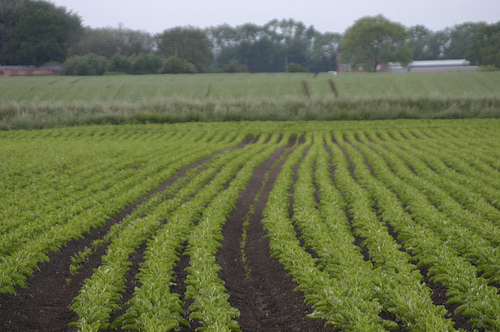An international food agency has urged government to carry out “structural transformation” by pouring investments in farm research & development, infrastructure, labor-intensive manufacturing and services, and land distribution in order for rural economies to grow.

The International Food Policy Research Institute (IFPRI) which is co-implementing a $2.5 million ASEAN market development work told a SEARCA inception program that policy transformation like those adopted by China will play a huge role in rapidly lifting rural areas into progress.
SEARCA—Southeast Asian Regional Center for Graduate Study & Research in Agriculture—is a co-implementor of this ASEAN project financed by the International Fund for Agricultural Development (IFAD) called “ASEAN Transformation & Market Integration” or ATMI.
“The design and implementation of institutions, policies and investments (in countries) have influenced the path and speed of rural transformation and … poverty reduction. Land reform, rural investments and sectoral policies have been decisive,” said Kevin Chen, IFAD senior research fellow at the SEARCA ATMI program.
China’s rural development success, according to Chen, is particularly attributable to the following:
· Land redistribution in 1982, market reform, trade liberalization. Huge investment in infrastructure
· Rapid structural transformation—investments in manufacturing and services through decentralization, foreign direct investment (FDI), and regional competition
· Substantial agricultural research & development
One ASEAN
The dream toward a “one ASEAN” through market integration (ATMI) was conceived as a result of the 2007-2008 food crisis when rice price shot up in the market beyond $1,000 per ton. ASEAN member nations adopted the ASEAN Integrated Food Security and Strategic Plan of Action (SPA) on Food Security which now covers 2015-2020.
ATMI aims to integrate small farmers into bigger business systems—called value chain which does the series of business activities from farming to processing, marketing, and distribution. It will make them competitive as numerous small farmers’ production are consolidated into one bigger supply bulk.
Smallholder agriculture
The role of small farmers to rural economic growth is tremendous as small farmers tending 1-2 hectares make up 85% of all land holdings and those holding less than 0.5 hectares make up 70%. These suffer the most from poverty and hunger. Philippines itself placed 68 in the 2016 ranking for Global Hunger Index out of 118 countries.
These are among the principles structural transformation is anchored.
1. Land distribution enhances productivity as farmers have the incentive to work hard if they have security of land tenure. It is also important that they can consolidate farmlands into bigger tracts so they can have economies of scale and be competitive.
2. With an effective social security system available equally to farmers especially the minorities—women, disabled, or cultural minorities, inequality is reduced, and minorities become productive.
3. For countries with slow development, investments in more roads, land preparation and post harvest machines, processing machines obviously raise production of value added goods.
4. Market distortions should be eliminated, private sector investment attracted, financing made available, and centralization/bureaucracy eliminated.
5. Jobs creation should be prioritized in rural non-farm economy. In urban and semi-urban areas, the focus of jobs creation should be in services and industry.
6. Market and pricing policies should be encouraging for investments in agriculture to grow.
7. Since a significant part of rural population is taken up by women and other minorities, it is important to adopt policies that give them equal access to land, asset ownership, credit, education, health services, and other productive assets.
With rural transformation, poverty in ASEAN’s developing countries has been successfully reduced from 71%in 1981 to 15% in 2011 (based on purchasing power). Based on $1.25 a day poverty yardstick, poverty rate in ASEAN was cut from 91% in 1981 to 40% in 2011.
Chen said agricultural transformation involves the simultaneous development of the processing industry (including food processing) and services sectors (logistics, marketing) through “value chain development.”
The stages of transformation are 1. Development of the wholesale/logistics segment as public and private sectors and foreign institutions pour investments 2. Processing booms as small and medium enterprises thrive from grain mills and dairy, meat, fish and produce processing and large scale plants also develop from consolidation due to improved policies. 3. More private retailers shoot up especially in light of e commerce.
As an end goal, integration as aimed in ATMI is considered successful when agriculture diminishes to just one of the many major sectors of the economy. Transformation happens as a country progresses from agriculture-based economy, to pre-transition, transition to urbanization, and developed stage.
Unfortunately there are factors that hinder rural farm growth called the “Paradox of East Asia Paradigm” of Zhang.
This is a situation where a developing country shifts from labor surplus to rural hollowing or when the labor force migrates or moves to cities—leaving the provinces with no people who want to tend farms.
Farmlands are abandoned further as importation of farm goods strip farmers of incentives of higher prices for their farm products.
The paradox also involves shifting from comparative advantage to import dependence.
As population increases, farms are divided and become smaller for farmers to achieve economies of scale. The solution is land reform. Population explosion is worsened as people change diet to western style—consuming more dairy and animal products from previously a diet of rootcrops and fruits-vegetables.
“Small farms are facing increasing disadvantages, including rapidly increasing wage rate, decline of production efficiency comparing to large farms, and difficulty of expanding farm size due to imperfection of land markets.” (Growth Publishing for SEARCA).
For any questions or interview requests, please contact 0929-715-8669 (Growth Publishing for SEARCA).
